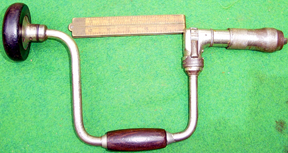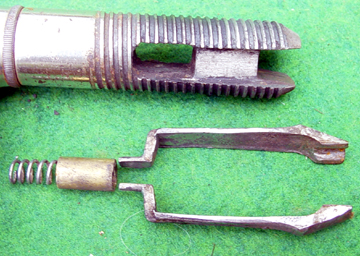Henry L. Stevens
At the time of the award of his single brace patent, H. L. Stevens lived in
Millers Falls, Massachusetts, and most likely worked for the Millers Falls
Company. His patent, No. 229,197 was registered on June 22, 1880 and is a
curious one.
Remember that William Barber patented his classic chuck and jaws on
May 24, 1864, and sometime later sold the rights to it to the fledgling Millers
Falls Mfg. Co. His design featured two independent jaws, that separately
hooked into the top of a coiled spring which pushed the jaws toward the open
mouth of the chuck shell. The jaws were kept from collapsing in on each
other by a shelf of steel produced by the incomplete machining of the slot in
the threaded core of the chuck that made room for the jaws. As discussed
on the Millers Falls page, this seminal design was dramatically improved upon
just a year and a half later by Charles Amidon's "Improved Barber Chuck" ( Oct
3, 1865). This improvement involved doing away with the spring, opening
the slot in the threaded core completely, and loosely pinning the two jaws
together at the base. It almost immediately proved to be a superior design
and quickly dominated the Millers Falls production line.
As pointed out earlier, true Barber chucks are quite uncommon in
Millers Falls Braces, supposedly because the Amidon's improved design was
superior. Indeed more true Barber chucks are found in non-Millers Falls
braces (generally made by smaller companies) than are found in those marked by
Millers Falls . In fact, all of the true Barber chucks that I've seen in
Millers Falls braces have been in those marked by the founding Millers Falls
Mfg. Co. This suggests the conjecture that the Millers Falls Co. may have sold
limited rights to the original Barber patent to smaller and non-threatening
companies, while reserving the "improved Barber" chuck for itself.
Now enter Mr. Henry Stevens. Stevens' 1880 patent is for what amounts
to the classic Barber patent chuck, with the singular addition of a brass tube
that contains the coiled spring into which the independent jaws are hooked.
The idea is simple, and probably effective. Barber's original design uses
three elements in the jaw system--a coiled spring and two jaws. The
spring, especially, was prone to escaping when the jaws were removed could be
lost. By containing the spring within a tube Stevens' invention makes that
spring loss much less likely. But, you have to ask, "So what"?
The patent is for an improvement on a jaw system that was less reliable and
probably more expensive than that of the Improved Barber chuck. It was
awarded 16 years after the original Barber patent (that Millers Falls did not
have in production) and 15 years following Amidon's improvement. It
certainly is possible that Millers Falls, through Mr. Stevens, was preserving
its rights to a patent (Barber's) that may have been something of a cash
calf--if indeed it was being sold to lesser companies.
If this is true, the strategy did not work for examples of Stevens' patent
seem to be extremely rare--in Millers Falls braces as well as in smaller
companies that might have been assignees. Indeed, it is a patent recorded
by Ron Pearson as being "Not Seen." And to this point I had not seen one
either.
But "this point" has come; and it was at the May edition of the Brimfield
Antiques Fair in Brimfield, Mass. that I discovered an intact and clear example
of Mr. Stevens patent. And most surprising, it is in a Millers Falls No.
62 Ratchet Bit brace, clearly marked with the Millers Falls Co. name and the
June 22, 1880 patent date on the chuck!


The brace, by the way, looks like an 1880s product, having pewter retaining
rings at the wrist handle and a knurled and marked chuck shell. Except for
the addition of the brass tube, the jaws, spring, and chuck core are nearly
identical to the original Barber patent chuck.
So, Millers Falls did use this patent! Later I've seen another example
of this patent on a No. 63 Millers Falls Brace.
Return to Brace INDEX



